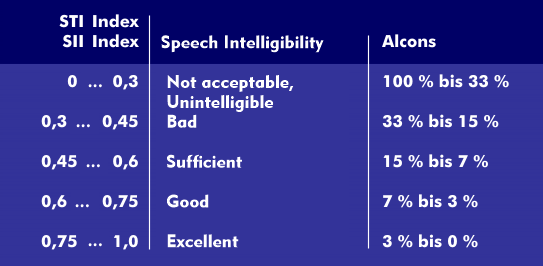speech intelligibility index (acoustics) (SII)
There are several assessment methods for evaluating speech intelligibility. These include the Speech TransmissionIndex( STI), the relatively old Articulation Index( AI) and the Speech Intelligibility Index (SII) derived from the STI index.
Most evaluation methods are based on the comparison of the signals radiated by the loudspeaker with those picked up by the microphone. Modulated audio signals are generated as speaker signals in many methods, including the SII index. The sound waves recorded by the microphone are filtered using certain filter characteristics and compared with the loudspeaker signals. The deviations in modulation depth and the proportion of interference and background noise are then used to evaluate several frequency ranges, and the results are averaged according to an algorithm.
The SII index is derived from the STI index. It is a machine evaluation method for speech intelligibility standardized by ANSI. The ANSI standard allows four measurement procedures, each with a different number and width of frequency bands. These frequency bands are selected from 21 critical frequency bands, 18 third octave bands, 17 equally spaced critical bands and 6 octave bands.
Like the STI index, the SII index can take values between "0" and "1". "0" stands for unacceptable speech intelligibility, "1" for excellent.
As a machine method, the SII index shows good agreement with static ratings, especially supporting broadband ratings between 150 Hz and 8.5 kHz, but also narrowband ratings with the critical bands.

